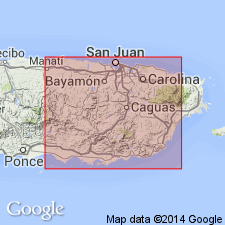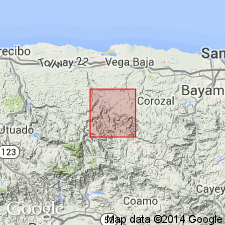
- Usage in publication:
-
- San Sebastian formation*
- Modifications:
-
- Revised
- AAPG geologic province:
-
- Caribbean region
Summary:
Sediments ranging from coarse bouldery gravel through sand, silt, clay, and marl to pure limestone, characterized by rapid lateral changes in lithology and intergrading both horizontally and vertically, are named the Rio Guatemala group. The San Sebastian formation represents the first interval of clastic deposition; the Lares limestone represents biohermal areas; and the Cibao marl with its Guajataca member represents the second interval of clastic deposition. Maximum thickness is 700 m. Unconformably overlies rocks of Late Cretaceous age; conformably underlies Aguada limestone. Age is Tertiary.
Source: GNU records (USGS DDS-6; Reston GNULEX).

- Usage in publication:
-
- San Sebastian Formation*
- Modifications:
-
- Revised
- AAPG geologic province:
-
- Caribbean region
Summary:
San Sebastian Formation, along with the Lares and Cibao Formations of the Rio Guatemala Group, is considered a separate unit in the Ciales quadrangle. This heterogeneous and lenticular formation is here divided into a lower sand and gravel member (0 to 80 m thick) and an upper sandy limestone member. Age is Oligocene.
Source: GNU records (USGS DDS-6; Reston GNULEX).

- Usage in publication:
-
- San Sebastian Formation*
- Modifications:
-
- Overview
- AAPG geologic province:
-
- Caribbean region
Summary:
The San Sebastian Formation occurs on the north coast of Puerto Rico and consists of shaly clay, sandstone, and conglomerate. Maximum estimated thickness is 100 meters exposed and is 328 meters in the subsurface. The San Sebastian is of middle and late Oligocene age.
Source: GNU records (USGS DDS-6; Reston GNULEX).
For more information, please contact Nancy Stamm, Geologic Names Committee Secretary.
Asterisk (*) indicates published by U.S. Geological Survey authors.
"No current usage" (†) implies that a name has been abandoned or has fallen into disuse. Former usage and, if known, replacement name given in parentheses ( ).
Slash (/) indicates name conflicts with nomenclatural guidelines (CSN, 1933; ACSN, 1961, 1970; NACSN, 1983, 2005, 2021). May be explained within brackets ([ ]).

